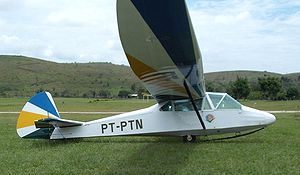Neiva B Monitor Video - Picture

|
|
Neiva B Monitor

Role: two-seater training sailplane
National origin: Brazil
Manufacturer: Indxºstria Aeronx¡utica Neiva
Designed by: Jose Carlos de Barros Neiva
First flight: 1945
Introduced: 1950
Number built: 21+
Developed from: Grunau Baby
The Neiva B Monitor, also designated B-2, is a Brazilian tandem two-seat glider aircraft designed and manufactured by Indxºstria Aeronx¡utica Neiva between 1945 and 1955 for primary training and general flying.
Design and development
The B Monitor was designed by Jose Carlos de Barros Neiva after the end of World War II. At that time Brazil was conducting the "Campanha Nacional de Aviax§x£o" (National Aviation Campaign), a nationwide program focused on re-equipping and incentivizing Aero clubs and the aeronautical industry. The lack of good performance gliders with good training qualities to replace the ageing and obsolete sailplane training fleet, composed in its majority by German types of the 1930s, was acute. Jose Carlos de Barros Neiva designed then a glider which conserved the best characteristics of the Grunau Baby, widely used in Brazil at the time. The first prototype, registered PP-PCB had its maiden flight in 1945, and the type certificate was given in 1950. The âCampanha Nacional de Aviax§x£oâ bought the first prototype and other 20 aircraft for the aero clubs. A small number of 3 B-monitor were built with a different nose and different materials in the mid-1950s.
Construction
The Monitor is largely a wooden aircraft. Its high wings are built around a single box spar, with a torsion resisting, plywood covered leading edge. Behind the spar the wing is fabric covered. Dihedral is just 0.5°. The wings are braced to the lower fuselage with a pair of single lift struts. The ailerons are wood framed and fabric covered; spoilers are wooden.
The fuselage is mainly built with wood, a semi-monocoque construction with steel tubes for wing attachments. The two seat cockipt has dual controls. The empennage is conventional, with a cantilever tailplane mounted on top of the fuselage. The landing gear is a forward skid with elastic dampers and a single, fixed wheel aft of the centre of gravity.
Operational history
The B-Monitor were used in many aero clubs and have trained hundreds of pilots. Many Brazilian soaring records were established in the type and it continues to be used as a primary trainer in some of the larger Brazilian aero clubs, including CVV-CTA in Sx£o José dos Campos/Ipux£, Rio Claro, Osx³rio, and Tatux.
Specifications
Data from Jane's All the World's Aircraft 1956/7 p. 43
General characteristics
Crew: 1 pilot
Capacity: 1 passenger
Length: 7.10 m (23 ft 3.5 in)
Wingspan: 15.86 m (52 ft 0 in)
Height: 1.13 m (3 ft 9 in)
Wing area: 18.40 m (198 ft)
Aspect ratio: 13.67
Wing profile: GÅttingen 535
Empty weight: 210 kg (462 lb)
Gross weight: 360 kg (792 lb)
Performance
Maximum speed: 145 km/h (90 mph)
Stall speed: 52 km/h (32 mph)
Maximum glide ratio: 21
Pereira de Andrade, Roberto (1976). A Construx§x£o Aeronx¡utica no Brasil 1910/1976. Sx£o Paulo: Editora Brasiliense.
Pereira de Andrade, Roberto (1997). Enciclopédia de Avixµes Brasileiros. Sx£o Paulo: Editora Globo. ISBN 8525021377.
Bridgman, Leonard (1956). Jane's All the World's Aircraft 1956-57. London: Jane's All the World's Aircraft Publishing Co. Ltd.
Neiva B Monitor Pictures
More airplane videos.
Source: WikiPedia